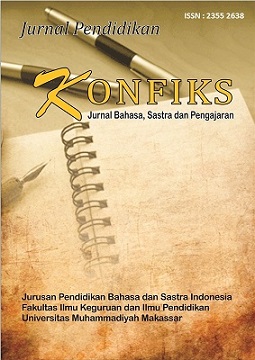THE RELATIONSHIP BETWEEN SELF-CONFIDENCE AND WILLINGNESS TO COMMUNICATE IN ARABIC LANGUAGE LEARNING PROCESS
DOI: https://doi.org/10.26618/konfiks.v12i1.18885
Arabic language learning, self-confidance, willingness to communicate
Abstract
Low student participation in communication during Arabic language learning often poses a significant barrier to the development of language proficiency. One of the psychological factors believed to influence this participation is self-confidence, which is closely associated with the concept of Willingness to Communicate (WTC). WTC reflects an individual's readiness to initiate communication in a second or foreign language, and it is considered a critical predictor of successful language use in instructional contexts. This study aims to investigate the relationship between self-confidence and WTC in the context of Arabic language learning. Employing a quantitative research design with a survey approach, data were collected through a structured questionnaire administered to university students. The data were then analyzed using correlation techniques to examine the strength and direction of the relationship between the two variables. The findings indicate a significant positive correlation between self-confidence and WTC, suggesting that students with higher self-confidence levels are more likely to engage actively in communication during language learning activities. These results contribute to the field of language education by highlighting the importance of psychological factors in communicative competence. The study underscores the need to incorporate strategies that foster students’ self-confidence as a means to enhance their willingness to communicate, thereby promoting more effective and interactive Arabic language instruction.
References
Annisa, M. N., & Safii, R. (2023). Analisis Kebutuhan Belajar Bahasa Arab sebagai Bahasa Asing dalam Konteks Pendidikan Tinggi. ELOQUENCE : Journal of Foreign Language, 2(2), Article 2. https://doi.org/10.58194/eloquence.v2i2.861
Balaka, M. Y. (2022). Metodologi penelitian kuantitatif. https://repository.penerbitwidina.com/media/publications/464453-metodologi-penelitian-kuantitatif-10d6b58a.pdf
Bensalem, E., Thompson, A. S., & Alenazi, F. (2023). The role of grit and enjoyment in EFL learners’ willingness to communicate in Saudi Arabia and Morocco: A cross-cultural study. Journal of Multilingual and Multicultural Development. https://www.tandfonline.com/doi/abs/10.1080/01434632.2023.2200750
El Hasbi, A. Z., Damayanti, R., Hermina, D., & Mizani, H. (2023). Penelitian Korelasional (Metodologi Penelitian Pendidikan). Al-Furqan: Jurnal Agama, Sosial, Dan Budaya, 2(6), 784–808.
Fadhilah, I. (2022). Faktor Kecemasan Siswa Dalam Berbicara Bahasa Inggris pada Mahasiswa Universitas Muhammadiyah Jakarta. Indonesian Research Journal on Education, 2(1), 96–105.
Ginanjar, E. G., Darmawan, B., & Sriyono, S. (2019). Faktor-Faktor yang Mempengaruhi Rendahnya Partisipasi Belajar Peserta Didik SMK. Journal of Mechanical Engineering Education (Jurnal Pendidikan Teknik Mesin), 6(2), Article 2. https://doi.org/10.17509/jmee.v6i2.21797
Khalilah, Z., Afif, M. N., Gamal, M., & Amalia, S. (2024). Analisis Faktor-Faktor Penghambat Berbahasa Arab Pada Alumni Pondok Pesantren di Program Studi Pendidikan Bahasa Arab UIN Sumatera Utara. Nashr al-Islam: Jurnal Kajian Literatur Islam, 6(3), Article 3. https://journalpedia.com/1/index.php/jkli/article/view/3226
Liu, C. (2023). The Effects of Task Repetition on Chinese EFL University Students’ Task Accomplishment, Communicative Competence, and Willingness to Communicate [PhD Thesis, Concordia University]. https://spectrum.library.concordia.ca/id/eprint/992027/
Macintyre, P., Clément, R., & Donovan, L. (2002). Willingness to Communicate in the L2 Among French Immersion Students.
Macintyre, P. D., Clément, R., Dörnyei, Z., & Noels, K. A. (1998). Conceptualizing Willingness to Communicate in a L2: A Situational Model of L2 Confidence and Affiliation. The Modern Language Journal, 82(4), 545–562. https://doi.org/10.1111/j.1540-4781.1998.tb05543.x
Makarim, B. (2024). Pengaruh Motivasi Belajar Bahasa Inggris, Kepercayaan Diri, dan Faktor Demografi terhadap Willingness to Communicate in English Language Siswa di Pondok Pesantren Al-Ittihad Cianjur [B.S. thesis, Fakultas Psikologi UIN Syarif Hidayatullah Jakarta]. https://repository.uinjkt.ac.id/dspace/handle/123456789/79527
Maryani, N., Ardiansyah, A. A., & Hasan, A. M. (2024). Arabic Language Learners as an Example of Their Willingness to Communicate in a Second Language (L2-WTC) Accomplishment. Jurnal Al Bayan: Jurnal Jurusan Pendidikan Bahasa Arab, 16(2). https://doi.org/10.24042/albayan.v16i2.24312
Mukarom, A. M. (2024). Eksplorasi Faktor Individu Peserta Didik dalam Pembelajaran Bahasa Kedua: Analisis Isi Buku Rod Ellis. Borneo Journal of Islamic Education, 4(1), Article 1. https://doi.org/10.21093/bjie.v4i1.9114
Nasution, I. D. N., & Setiawan, H. R. (2024). Penerapan Media Flash Card dalam Peningkatan Penguasaan Kosakata Bahasa Arab Peserta Didik di Rumah Belajar Madani Yakesma. Reslaj: Religion Education Social Laa Roiba Journal, 6(9), Article 9. https://doi.org/10.47467/reslaj.v6i9.4975
Peng, J.-E., & Woodrow, L. (2010). Willingness to Communicate in English: A Model in the Chinese EFL Classroom Context: Willingness to Communicate in English. Language Learning, 60(4), 834–876. https://doi.org/10.1111/j.1467-9922.2010.00576.x
Pramesti, A., & Hakim, S. N. (2023). Kepercayaan Diri Mahasiswa Ditinjau dari Harga Diri dan Kebersyukuran [PhD Thesis, Universitas Muhammadiyah Surakarta]. https://eprints.ums.ac.id/id/eprint/116135
Šafranj, J., & Katić, M. (2019). The Relationship between Big Five Personality Traits and Willingness to Communicate. Pedagoška Stvarnost, 65(1), Article 1. https://doi.org/10.19090/ps.2019.1.69-81
Sugiyono, S., & Lestari, P. (2021). Metode penelitian komunikasi (Kuantitatif, kualitatif, dan cara mudah menulis artikel pada jurnal internasional). Alvabeta Bandung, CV. http://eprints.upnyk.ac.id/27727/1/Buku%20Metode%20Penelitian%20Komunikasi.pdf
Syafitri, A., Yundayani, A., & Kusumajati, W. K. (2019). Hubungan antara Kepercayaan Diri Siswa terhadap Kemampuan Berbicara Bahasa Inggris. Prosiding Seminar Nasional Pendidikan STKIP Kusuma Negara, PING-052.
Syamaun, N. (2016). Pembelajaran Maharah al-Kalam untuk Meningkatan Keterampilan Berbicara Mahasiswa Program Studi Pendidikan Bahasa Arab Fakultas Tarbiyah dan Keguruan. LISANUNA: Jurnal Ilmu Bahasa Arab dan Pembelajarannya, 4(2), Article 2. https://doi.org/10.22373/l.v4i2.852
Yang, Y., Cui, Y., & Yao, S. (2024). Teacher support, grit and L2 willingness to communicate: The mediating effect of foreign language enjoyment. BMC Psychology, 12(1), 383. https://doi.org/10.1186/s40359-024-01877-5
Downloads
Published
Issue
Section
License
Authors who publish with this journal agree to the following terms:
The author owns the copyright and grants the journal rights for first publication with the work simultaneously licensed under a Creative Commons Attribution License which allows others to share the work with acknowledgment of the work's authorship and initial publication in this journal.
Authors may enter into separate additional contractual agreements for the non-exclusive distribution of the published journal version of the work (for example, posting it to an institutional repository or publishing it in a book), with acknowledgment of its initial publication in this journal.
Authors are permitted and encouraged to post their work online (for example, in institutional repositories or on their websites) before and during the submission process, as this can lead to productive exchanges, as well as earlier and larger citations of published work (See The Effect of Open Access).
Statement of Authenticity and Manuscript Copyright can be downloaded: Here
After filling in the statement letter, please send via e-mail: konfiks@unismuh.ac.id





.png)


